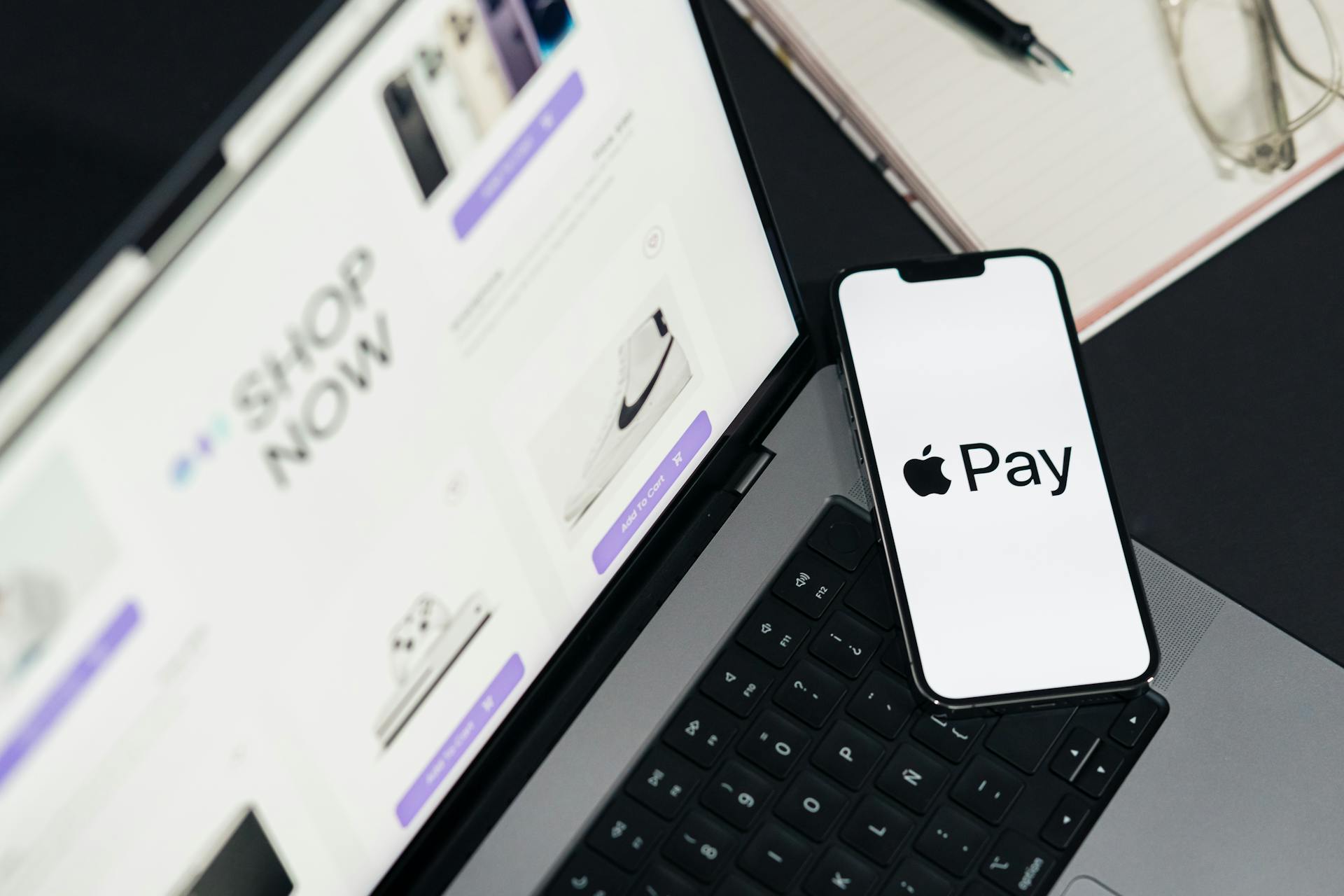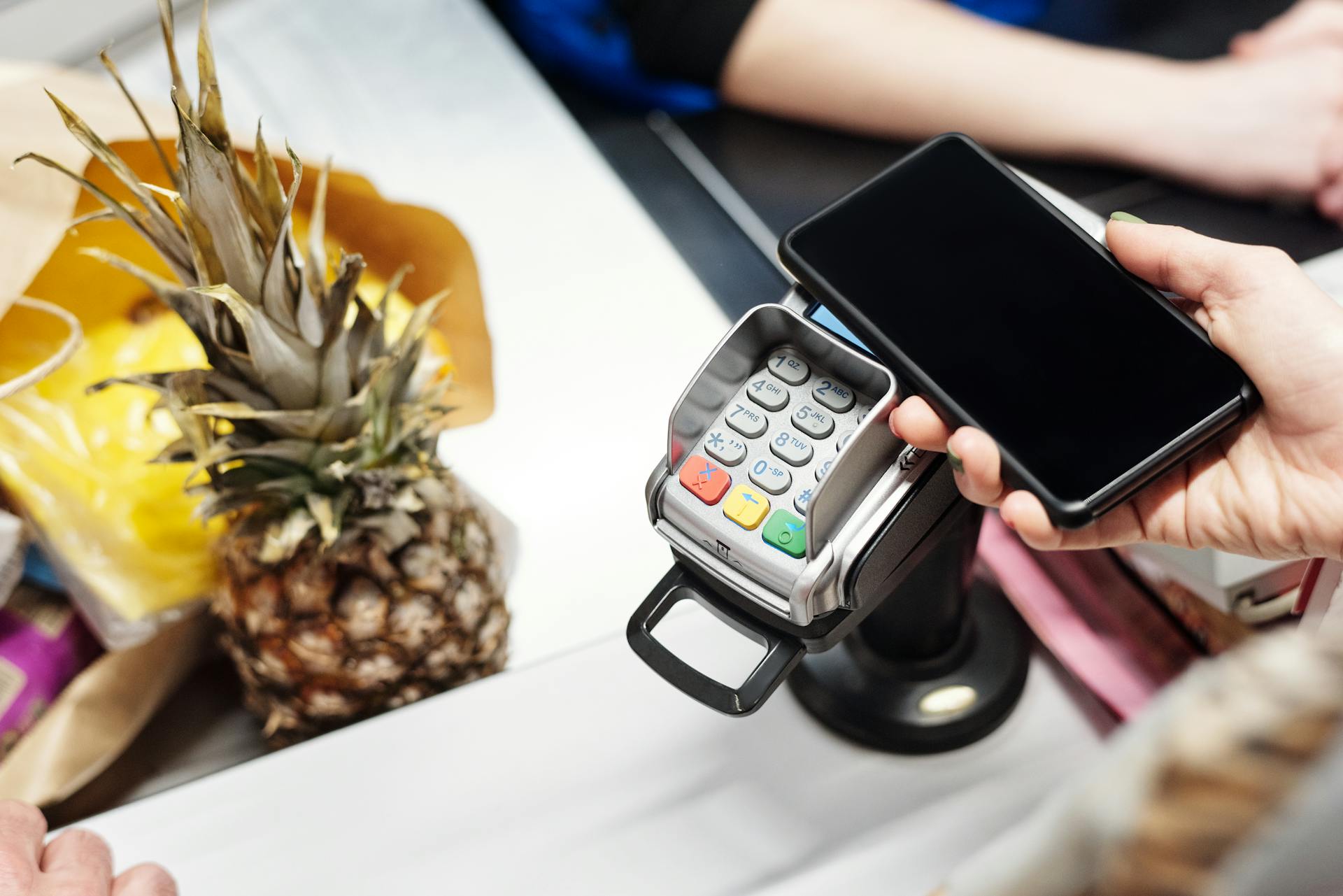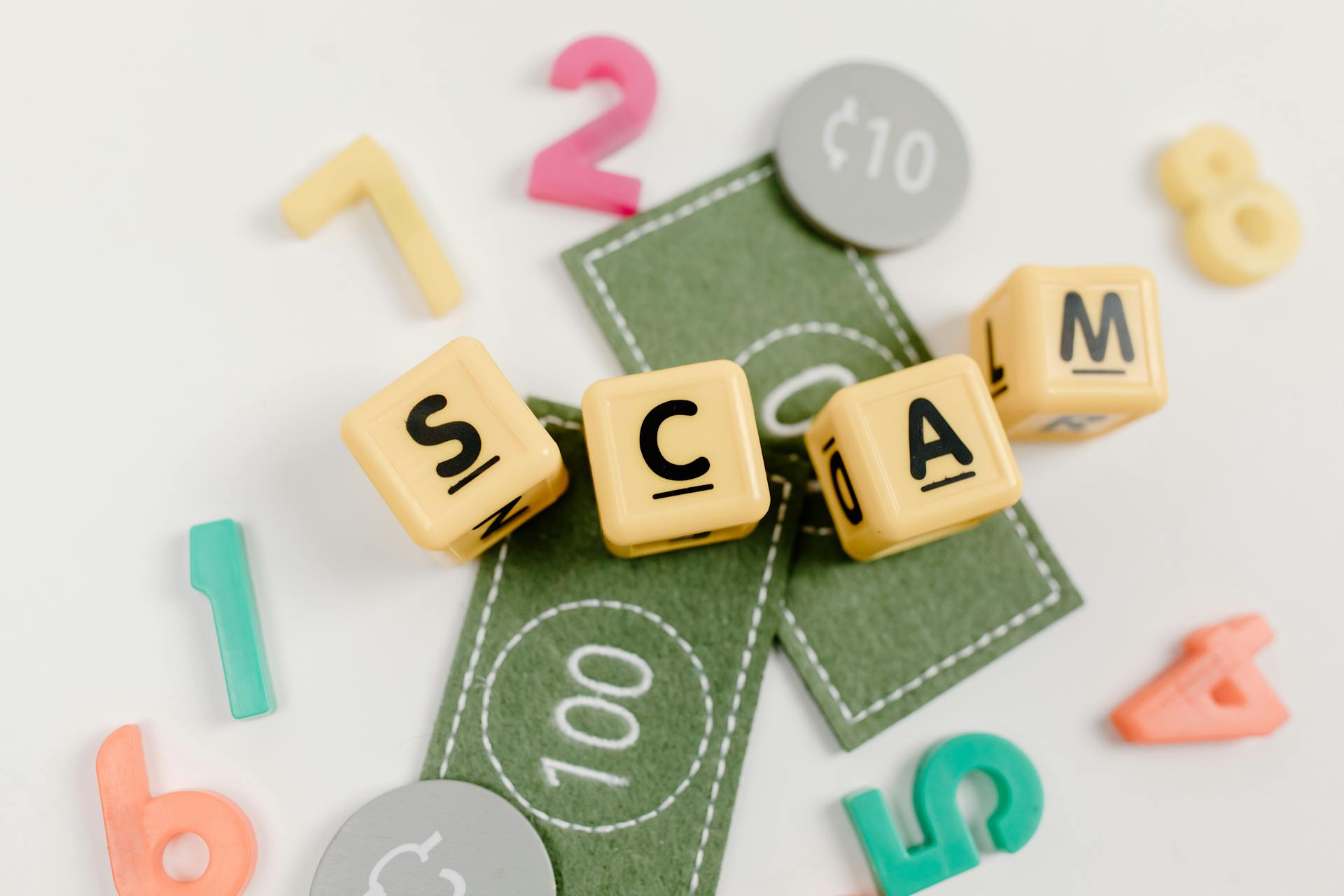
ApplePay scams are on the rise, and scammers are getting creative with their tactics. Scammers can send fake ApplePay texts that appear to be from Apple, asking you to verify your account or update your payment information.
These texts often contain a sense of urgency, claiming that your account will be suspended if you don't act quickly. However, the links and phone numbers provided in these texts are usually fake and can lead to identity theft or financial loss.
To avoid falling victim to these scams, be cautious of any unsolicited texts from Apple or ApplePay. Apple will never ask you to verify your account or payment information via text message.
For another approach, see: Apple Cash Fraud Scam
What Is the Scam?
The Apple Pay scam is a common and basic fraudulent scheme that targets Apple users. It starts with a message that mimics official communication from Apple, often a direct text message to your phone or an email letter.
The message typically reads something along these lines: "Your Apple Pay was charged $143.95. If unauthorized, click here [fake-link.com] or call (833) 555-6789." This message is designed to look legitimate and cause panic.
Scammers rely on panic to push you into quick action, which is why it's essential to remain calm and not click on suspicious links or call unknown numbers.
Expand your knowledge: Student Loan Forgiveness Call Scam
How It Works
Apple Pay is a digital wallet and contactless payment technology designed exclusively for Apple devices. With 85% of U.S. retailers accepting Apple Pay, it's likely you've already used it to make a payment.
To use Apple Pay, you need to link a credit or debit card to your Apple Pay account, which can include MasterCard, Visa, American Express, or payment cards associated with U.S. Federal programs.
When you see the Apple Pay logo or use a website that accepts Apple Pay, you can pay using your linked card on your device. You don't need to use your PIN, as you can verify the payment using biometric information such as your fingerprint or facial scan.
Explore further: Shop Pay Scams
Here's how Apple Pay creates a secure transaction:
- A unique transaction code is generated for every purchase.
- A device-specific code is also created for each transaction.
This means that even if you make a purchase on a shady website, scammers can't steal your credit card numbers. However, it's still possible for scammers to steal your money using Apple Cash.
Phishing and Scam Messages
Phishing and Scam Messages are a major concern when it comes to Apple Pay. Scammers often send fake emails or text messages that appear to be from Apple, claiming your account is suspended or compromised, and asking you to click a link to verify your information.
These links lead to a fraudulent website designed to steal your Apple ID, passwords, or payment details. To avoid falling for this scam, never click on links in unsolicited emails or text messages. Instead, go to the official Apple website or contact Apple Support directly.
If you receive a text message claiming your Apple Pay account has been compromised, do not click on the link. Instead, reach out to Apple Support directly at support.apple.com/contact to see if there are issues with your account.
Expand your knowledge: Fake Payday Loan Collection Calls
Here are some common phishing scams to watch out for:
- Phishing scams that claim your Apple Pay account has been suspended or compromised
- Fake lottery or prize scams that ask you to pay a small fee through Apple Pay
- Unsolicited payment requests or messages from unknown senders
If you receive any of these types of messages, report them to Apple immediately. You can send any phishing scam email or unsolicited payment request to [email protected].
Unexpected Gift Card
If someone asks for gift cards and insists on immediate payment, it's almost certainly a scam. Scammers may contact victims claiming an urgent need for gift card payments to handle emergencies or pay off debts.
Apple gift cards are not a legitimate payment method for debts or emergencies. Scammers may try to trick you into buying gift cards to pay for something that doesn't exist.
Don't fall for it, even if the scammer is convincing or claims to be from a trusted organization. Gift cards are a common target for scammers, and they can be used to steal your money.
See what others are reading: Tap to Pay Scams
Unsolicited Messages
Unsolicited Messages can be a red flag for phishing scams. If you receive a message claiming your Apple Pay account has been compromised, don't click on any links. Instead, go to the official Apple website or contact Apple Support directly.
Receiving unexpected payment requests or payments from someone you don't know is often a sign of fraud. Scammers may send small amounts to initiate contact or try to trick you into refunding money that was "accidentally" sent using stolen cards.
Here are some warning signs of unsolicited messages:
- Unsolicited Apple Pay payments, which may be sent using a stolen credit card
- Unsolicited requests for payment on Apple Pay, which may be an imposter scam
- Messages claiming you've won a prize or lottery, but need to pay a small fee through Apple Pay
These types of messages can be designed to create a sense of urgency, so be cautious and don't act impulsively. If you receive an unsolicited message, report it to Apple by sending an email to [email protected] or tapping "Report Junk" in your messages app.
Scam Prevention
If you receive an unexpected payment request through Apple Cash, it's likely a scam. Unsolicited payment requests or payments from people you don't know are often a sign of fraud.
To protect yourself, only send money to family and friends, and treat Apple Cash like physical cash. Be cautious on public Wi-Fi and avoid entering sensitive information when on public networks.
You might enjoy: Cash App Card Scam
Here are some common tactics used by scammers:
- Phishing emails or texts to steal your Apple ID credentials and payment information
- Impersonating Apple support to trick users into sharing two-factor authentication codes
- Sending overpayments using stolen cards and requesting refunds
If you receive a suspicious payment request or payment, avoid interacting with it and report the activity to Apple immediately. You can report phishing scams to Apple by sending an email to [email protected].
Change your Apple ID password and security settings after reporting the fraud, and enable two-factor authentication (2FA) to add an extra layer of security.
Warning Signs and Red Flags
Apple Pay scams are designed to catch victims off-guard, creating urgency or playing on trust. These scams are often subtle, but there are warning signs to watch out for.
Scammers often use unverified domains or generic email providers, not "@apple.com." Be cautious of messages from random numbers or poor grammar, such as "Your account is been restricted."
Unverified links and numbers are also a giveaway. Scam messages may include links that lead to fake websites designed to look like Apple's, but the URLs will seem off if you inspect them carefully.
Urgency tactics are another red flag. Phrases like "Immediate action required" are meant to create panic and get you to act before thinking.
Here are some key red flags to look out for:
- Suspicious Senders: Scammers often use random numbers or generic email providers, not "@apple.com."
- Poor Grammar or Phrasing: Errors like "Your account is been restricted" are clear signs of fraud.
- Unverified Links and Numbers: Scam messages often include links that lead to fake websites designed to look like Apple's.
- Urgency Tactics: Phrases like "Immediate action required" are meant to create panic.
Steps to Take After a Scam
If you've fallen victim to an Apple Pay scam, acting quickly is crucial to contain the damage and increase the chances of recovering your funds.
Change your passwords, starting with your Apple ID, and make sure your new password is strong and unique. This will prevent scammers from accessing your account. Avoid reusing old passwords or relying on predictable patterns like birthdays or common words.
Enable Two-Factor Authentication to add an extra layer of security. This feature makes it harder for scammers to access your account.
Notify your bank if you shared financial details, and they can monitor for unauthorized transactions and secure your accounts. Check for fraudulent charges in your Apple Pay and bank account activity, and report any suspicious transactions immediately.
Contact Apple Support and your bank or card issuer immediately to report the fraudulent transaction. Apple Support can guide you through the process and provide advice on what to do next. This is especially important if the scam involves unauthorized access to your Apple ID or Apple Pay account.
Here are the steps to take if you've been scammed on Apple Pay:
- Change your Apple ID password and enable Two-Factor Authentication
- Notify your bank about the scam and monitor for unauthorized transactions
- Check for fraudulent charges in your Apple Pay and bank account activity
- Contact Apple Support and your bank or card issuer to report the fraudulent transaction
Common Scam Types
Scammers use phishing emails or texts to steal your Apple ID credentials and payment information, making it easy for them to access your account and steal your money.
Phishing scams are designed to trick users into giving away sensitive information, often by sending fake messages that look like they're from Apple, warning you that your account has been suspended or compromised.
You might receive an email or text that includes a link to what appears to be Apple's website, but it's actually a fake page set up by scammers. Always verify such messages by contacting Apple directly, and never click on suspicious links.
Scammers often send unsolicited payment requests through Apple Cash or Wallet, impersonating someone you know or claiming to represent a company, pressuring you to make payments immediately. These requests can also come with messages urging you to act quickly, such as claiming there is an urgent bill or prize awaiting payment.
Some scammers lure victims by claiming they have won a prize or offer to assist with an account problem, directing them to a fake Apple website or tricking them into providing personal details or payment information. These scams often rely on urgency, making the victim feel pressured to act immediately without verifying the legitimacy of the message.
Protecting Your Account
Be cautious of messages claiming your Apple Pay account is compromised or suspended, as scammers often use these tactics to create panic and trick you into clicking malicious links.
These phishing messages often urge you to click a link to secure your account, but it's best to verify such claims directly with Apple through official channels.
Never click on suspicious links or provide sensitive information in response to unsolicited messages.
Stay Safe
To avoid scams, only send money to people you know. This simple rule can save you from a lot of trouble.
Be cautious of phishing and social engineering attacks, as they're common tactics used by scammers. Don't let your guard down, even if the request seems legitimate.
Using public Wi-Fi networks can expose your data to hackers, so it's best to avoid making transactions or changing account settings when connected to one. Use your mobile data or a VPN for added security instead.
Never refund overpayments, as the original payment may have been made with a stolen credit card. This can leave you without both the product and the refund you sent.
Consider signing up for Aura for added security, but remember that no one can prevent all identity theft or cybercrime.
Reporting and Recovery
If you've fallen victim to an Apple Pay scam, it's essential to act quickly to contain the damage and increase your chances of recovering your funds.
Contact Apple Support and your bank immediately to report the fraudulent transaction. Apple Support can guide you through the process and provide advice on what to do next. This is especially important if the scam involved unauthorized access to your Apple ID or Apple Pay account.
Notify your bank or card issuer to report the fraudulent transaction. If the payment was made using a linked credit or debit card, your bank may initiate a chargeback to reverse the transaction. Credit card payments tend to have more protection compared to transactions made with Apple Cash, which functions similarly to cash and lacks buyer protection.
Acting quickly improves the likelihood of reversing fraudulent charges before further damage occurs. If you're using Apple Cash, you won't be able to reverse the transaction because you authorized the transfer.
Here are the steps to take if you've been scammed on Apple Pay:
• Contact Apple Support and your bank immediately
• Notify your bank or card issuer to report the fraudulent transaction
• Review your recent transactions in Apple Pay and report any suspicious transactions immediately
• Inform Apple and local authorities about the scam
• Change your passwords, enable two-factor authentication, and check for fraudulent charges
Remember, any money you may have already lost is likely gone for good, but taking these steps can help prevent further damage and secure your accounts.
Worth a look: Is the Charge Card Real
Frequently Asked Questions
How do I know if a text from Apple is genuine?
Verify the sender's name, not just the number, as genuine Apple texts display 'Apple' as the sender. Be cautious of unknown numbers and spoofed caller IDs, as scammers may try to mimic Apple's identity
Featured Images: pexels.com

